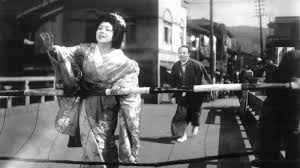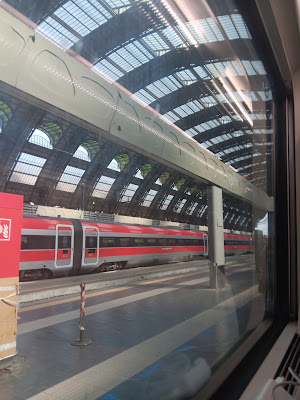 |
Alexander Kluge
|
Alexander Kluge was born in Halberstadt, Saxony-Anhalt in1932 and grew up prior to the war in a household full of music and culture. His father, a doctor, played the violin, counting actors and musicians among his patients and friends; social gatherings at the house included concerts and impromptu musical performances. The family home was levelled during an Allied bombing raid in the last month of the war.
Alexander played the piano and later studied organ and church music as well as modern history at university. Although he went on to study law, his strong interest in music and opera is evident throughout his film and television work. In The Power of Emotion (1983) Kluge condenses the story of ‘Aida’ into three minutes while retaining some of the emotional impact of operatic performance and spectacle in the visuals from an early silent film version of the opera combined with voice-over narration and traces of the music (Lutze 87). This use of narration combined with several types of ‘found’ visual materials is central to Kluge’s strategies of succinctly evoking an event while revealing characters’ subjectivities in an ‘anti-Hollywood’ narrative on a low budget.
 |
| Abschied von Gestern/Yesterday Girl (1966) |
Soon after completing graduation Kluge realised that law was less attractive to him. What drew him to film was the interaction with literature and music. He worked briefly as an assistant to Fritz Lang on his Indian films where he witnessed the ongoing humiliation of the great man by the producer Artur Brauner overriding Lang’s instructions on the set with his wife’s advice. Kluge was later always careful to maintain his autonomy by also producing his own films. He made four short documentary films before producing, writing and directing his first feature.
Kluge was the intellectual among the new directors, a lawyer and academic, a writer of documentary fiction, as well as theoretical works on politics, sociology, philosophy and aesthetics pioneered by the neo-Marxists of the Frankfurt school through Theodor Adorno's theory of modernist aesthetics in the arts and negative analysis of mass culture with an underlying hostility toward film. This was incompatible with Kluge’s commitments-wise approach to filmmaking “aptly characterized by the much abused epithet 'Brechtian'.” (Sandford 17). “He turned to Walter Benjamin who, like Brecht, was seriously interested in popular cultural forms and made a case for film as a potentially critical artistic medium specifically suited to the needs and experiences of a mass audience” (Fiedler 197-8 Phillips ed.). “The conjunction of radical politics and radical aesthetic form that characterizes much of twentieth century art is transformed by Kluge into a unique form of political modernism” (Lutze 33).
 |
Artisten in der Zirkuskuppel: Ratlos/Artists at the Top
of the Big Top:Disorientated (1968) |
Filmautoren
The notion of the 'Autorenkino' (author’s film) most clearly defined by Kluge, referred to the instatement of a personalised mode of production formulated by the Oberhausen group of aspiring filmmakers. Kluge believed that filmmakers should familiarise themselves with all aspects of production which enables them, as a 'Filmautoren' (film author), to exercise a high degree of authorial control (Knight 69, ‘Cinema Book’ Cook& Bernink eds), or as Fiedler places Kluge’s conception of the Autorenfilm : “the director in the role of producer as well as scriptwriter” (Phillips ed.198).
Lutze notes that there was a significant difference between the auteur directors in France and the autoren in Germany (53). Kluge commented that it was the mode of production - low budgets enabled by lightweight equipment - that became the “badge of authenticity” of the producer/directors of the Young German Cinema, rather than the particular content of their films (ibid 54). This informed the film subsidy agencies as the institutionalised paths to film authorship enabled the shaping of a national film movement. The emphasis on the training set by Kluge and Edgar Reitz at the Ulm Film Institute was on a four year all-round film-making education rather than on specialisation.
Timothy Corrigan has noted that both Miriam Hansen and Eric Rentschler have argued that “one of the most important collective gestures of contemporary German cinema may have been to re-situate the very notion of auteur” (New German Critique Winter 1990). Rentschler has shown, it is suggested, that Kluge was part of an anticipatory effort to de-centre the conventions of auteurism in cultural and historical terms while for Hansen it was more a matter of shifting the emphasis, in comparative terms, to the ‘politique des auteurs’ (see below). Corrigan adds that another way that Kluge mobilised auteurism as a critical category was less a critical subversion of auteurism as a production strategy, and more exploiting auteurism as a category for reception. “Indeed, the market shift within auteurism as a way of viewing and receiving movies, rather than as a mode of production, has been a central change in the meaning of auteurism in the sixties to the eighties. It is along these lines that Kluge has begun to make specific use of the commerce of his own singularity and subjectivity” (ibid 44).
 |
Gelegenheitsarbeit einer Sklavin/Occasional Work of
a Female Slave (1973) |
As Corrigan puts it: “Despite similar political leanings, Kluge is no Godard […] he ultimately turns sharply from the isolation of Godard’s sometimes radical film language, and ultimately away from the entire concept of a “politique des auteurs” which supports those individualistic notions of film language” (96). In support of his contention, Corrigan quotes Miriam Hansen : “While the post-Oberhausen film-makers naturally turned to the French New Wave for a mode, German Autorenkino was not only less homogeneous than its French counterpart but also developed different notions of authorship. Hansen identifies that for the New German Cinema the emphasis of ‘Autorenkino’ was “necessarily more on the ‘politique des auteurs,’ the political struggle for independent film-making in a country which did not have a film culture comparable to that of France” (quoted from an essay by Hansen in New German Critique 24/5 1981-2 p.41).
“Two Types of Realism”
In foreshadowing his later filmic essays, Kluge uses inserts of associative montage and a variety of references in the narratives to make ironic comment “on the relationship between past and present, the past being a precondition of the present, its weight by definition inescapable” (Kaes, ‘Heimat to Hitler’ 108). Or, as Kluge put it: “a better way to change things is to accept the past and to complete it. The only way to change history is to regain it.”
 |
DVD Cover
In Gefahr und größter Not bringt der Mittelweg den Tod,
co-directed with Edgar Reitz (1974)
|
Central to all of Kluge’s thinking about the cinema is what he sees, in Brechtian terms, as two types of realism. One involves the superficial reproduction of outward reality that merely confirms - and thereby affirms - the existence of what it shows and is most exemplified in the cinema by conventional documentaries. “The other form of realism is critical and subversive seeking out the truth beneath the deceptive face of the world rather than passive receptivity. The motive for realism is never confirmation of reality but protest” (Sandford 18). Realism must be produced, it is not a state of nature. The natural state is ideology and dream world which is the province of the commercial cinema (Jansen and Schutte ‘Herzog/Kluge/Straub’ 1976 quoted ibid). While he is critical of stereotypical ideology and dreams Kluge is also sceptical about the earnestness with which the ‘educated classes’ approach the cinema (ibid) as, one imagines, he would likely view feminist criticism of Occasional Work of a Domestic Slave as referred to above.
The senses, in Kluge's view, are wrongly dismissed as somewhat inferior to our consciousness. He sees the senses as “fundamental not only to our perception but to the organization of that perception into knowledge”. Sandford writes that in this “we are approaching the heart of Kluge's theory, “through the senses the cinema stimulates the audience's imagination, and it is this 'Phantasie' - the German word Kluge uses that seems to be the key term in his writings […] fundamental to [his] view of the way the cinema works” (18).
The film is potentially there already in the audience's imagination; it is the director's job to activate this potential.” Kluge further suggests “that for some tens of thousands of years film has existed in people's minds – streams of association, daydreams, experience, sense impressions, consciousness. The technical invention of film has simply added reproducible counterparts to this” (ibid). He has “often said that the film in the spectator’s head is more important than the one on the screen” (Liebman 162).
 |
In Danger and Deep Distress, the Middleway Spells
Certain Death (1974) |
Kluge has stressed on many occasions that “the relationship of film-maker to audience must not be one of domination.” […] His ideal cinema is “not a monologue, but cinema as dialogue, as something the audience can respond to – and not just respond, but make the cinema.” For Kluge, “dialogue with the real experiences of the audience, demands a new filmic language and this new language [can initially cause audience withdrawal] because they are not used to it […] all the rest of the language of film is stuck in habitual grooves.” It is important for Kluge that the audience ‘behave naturally’. If you find my films baffling, “stop worrying,” he advises, “just sit back and watch” (ibid). This direction of thought and its relation to the audience is directly reflected in Kluge’s adoption of an essay-like collage form in his feature films beginning with In Danger and Deep Distress, the Middleway Spells Certain Death made after Occasional Work. The success of Yesterday Girl seemed to encourage Kluge to further challenge viewers' imaginations with a similar, less accessible, treadmill-like circularity - as in Artists at The Top of the Big Top - Disorientated.
************************
Previous entries in this series can be found if you click the following links
Sixty Years of International Art Cinema: 1960-2020 - Tables and Directors Lists to Accompany Bruce Hodsdon's Series
Notes on canons, methods, national cinemas and more
Part One - Introduction
Part Two - Defining Art Cinema
Part Three - From Classicism to Modernism
Part Four - Authorship and Narrative
Part Five - International Film Guide Directors of the Year, The Sight and Sound World Poll, Art-Horror
Part Six (1) - The Sixties, the United States and Orson Welles
Part Six (2) - Hitchcock, Romero and Art Horror
Part Six (3) - New York Film-makers - Elia Kazan & Shirley Clarke
Part Six (4) - New York Film-makers - Stanley Kubrick Creator of Forms
Part Six (5) ‘New Hollywood’ (1) - Arthur Penn, Warren Beatty, Pauline Kael and BONNIE AND CLYDE
Part Six (6) Francis Ford Coppola: Standing at the crossroads of art and industry
Part 6(7) Altman
6(8) Great Britain - Joseph Losey, Lindsay Anderson, Karel Reisz, Richard Lester, Peter Watkins, Barney Platts-Mills
6(9) France - Part One The New Wave and The Cahiers du Cinema Group
6(10) France - Part Two - The Left Bank/Rive Gauche Group and an Independent
6(11) France - Part Three - Young Godard
6(12) France - Part Four - Godard:Visionary and Rebel
6 (13) France Part 5 Godard with Gorin, Miéville : Searching for an activist voice
6(14) France Part 6 - Creator of Forms - Bresson
6 (15) France Part 6 - Creator of Forms - Jacques Tati
6 (16) - Part 6 - Creator of Forms - Carl Th Dreyer
6 (17) - Italy and Luchino Visconti
6(18 - Italy and Roberto Rossellini - Part One
6(19) - Rossellini, INDIA and the new Historical realism
6(20) - Rossellini in Australia
6 (21) - Italy - Michelangelo Antonioni
6 (22) - Italy - Federico Fellini, Ermanno Olmi
6 (23) - Italy - Pasolini, Rosi
6 (24) - Interregnum - Director/Auteur/Autoren
6 (25) West Germany






























